MARCH KEY FIGURES
 |  | % change Dec qtr 04 to Mar qtr 05 | % change Mar qtr 04 to Mar qtr 05 |
|
| GDP (Chain volume measure) |  |  |
 | Trend | 0.4 | 1.5 |
 | Seasonally adjusted | 0.7 | 1.9 |
| Final consumption expenditure (Chain volume measure) |  |  |
 | Trend | 0.6 | 3.4 |
 | Seasonally adjusted | 0.4 | 3.1 |
| Gross fixed capital formation (Chain volume measure) |  |  |
 | Trend | 0.5 | 5.1 |
 | Seasonally adjusted | -1.6 | 4.3 |
| GDP chain price index |  |  |
 | Original | 0.9 | 3.7 |
| Terms of trade |  |  |
 | Seasonally adjusted | 1.1 | 7.6 |
| Real net national disposable income |  |  |
 | Trend | 0.5 | 2.3 |
 | Seasonally adjusted | 0.9 | 2.5 |
|
GDP growth rates, Chain volume measure, quarterly change
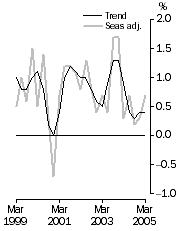
| Contributions to GDP growth, Expenditure - Seasonally adjusted
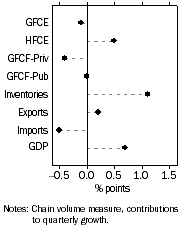
|
MARCH KEY POINTS
VOLUME GDP
- In trend terms, GDP increased by 0.4% in the March quarter. GDP per capita grew by 0.1%, GDP per hour worked in the market sector fell by 0.5% and real net national disposable income grew by 0.5%.
- In seasonally adjusted terms, GDP increased by 0.7% in the March quarter. Non-farm GDP also grew by 0.7%. Continued growth in the terms of trade is reflected in growth in real net national disposable income of 0.9% in the March quarter.
EXPENDITURE ON GDP
- In seasonally adjusted terms, the increase in expenditure on GDP was driven by contributions from changes in inventories (+1.2 percentage points) and household final consumption expenditure (+0.5 percentage points). These contributions were offset by negative contributions from net exports (-0.3 percentage points) and private gross fixed capital formation on machinery and equipment (-0.5 percentage points).
INDUSTRY GROSS VALUE ADDED
- There were small positive contributions from transport and storage, manufacturing, retail trade and finance and insurance.
NOTES
REVISIONS IN THIS ISSUE
Revisions have been made to a number of aggregates. As advised in recent related releases regarding retail turnover, new capital expenditure and balance of payments, revisions have been made to some input series to the quarterly national accounts. These revisions have impacted primarily on components within the expenditure measure of GDP. Combined with the inclusion of other more up-to-date source data and the impact of seasonal reanalyses in certain series, the net effect of all revisions on the December quarter 2004 estimate of seasonally adjusted GDP in volume terms has been to increase quarterly growth by 0.2 percentage points to 0.3%. The September quarter 2004 GDP volume growth remains unchanged at 0.2%.
CHANGES IN THIS ISSUE
There is concern regarding the robustness of the seasonal adjustment process for hours worked data, which is impacting on the quality of the quarter to quarter movements in seasonally adjusted terms for four series: Hours worked, Hours worked market sector, GDP per hour worked and GDP per hour worked market sector. These four series, which are presented in Table 2, have been suspended from the publication while the seasonal adjustment issues are resolved. Trend estimates of these series, presented in Table 1, are considered to be of suitable quality.
CHANGES IN THE NEXT ISSUE
There are two changes to the chain volume estimates that will be incorporated in the June quarter 2005 release. First, a new base year, 2003-04, will be introduced into the chain volume estimates and this will lead to revisions to growth rates in periods after 2003-04. Second, the chain volume estimates will be re-referenced to 2003-04 thereby preserving additivity in the quarters after the reference year. Re-referencing affects the levels of, but not the movements in, chain volume estimates.
INQUIRIES
For further information contact Patricia Mahony on Canberra (02) 6252 6711 for industry and income estimates, and Daniel Smith on Canberra (02) 6252 6713 for consumption, investment and trade estimates.
MAIN FEATURES EXPENDITURE CHAIN VOLUME MEASURES
 |  |  | Trend
| Seasonally adjusted
|  |
 |  |  | Quarterly % change Dec 04 to Mar 05 | Annual % change Mar 04 to Mar 05 | % points contribution to growth in GDP Dec 04 to Mar 05 | Quarterly % change Dec 04 to Mar 05 | Annual % change Mar 04 to Mar 05 | % points contribution to growth in GDP Dec 04 to Mar 05 |  |
|  |
| Final consumption expenditure |  |  |  |  |  |  |  |
 | General government | 0.3 | 2.7 | 0.1 | -0.6 | 2.2 | -0.1 |  |
 | Households | 0.7 | 3.6 | 0.4 | 0.8 | 3.4 | 0.5 |  |
| Gross fixed capital formation |  |  |  |  |  |  |  |
 | Private |  |  |  |  |  |  |  |
 |  | Dwellings | -2.0 | -4.6 | -0.1 | -0.5 | -3.8 | - |  |
 |  | Business investment | 1.8 | 13.1 | 0.3 | -2.6 | 11.1 | -0.4 |  |
 |  | Ownership transfer costs | -2.6 | -18.9 | - | -1.7 | -17.1 | - |  |
 | Public | 0.5 | 4.5 | - | 0.2 | 4.5 | - |  |
| Changes in inventories |  |  |  |  |  |  |  |
 | Private non-farm | . . | . . | 0.2 | . . | . . | 1.2 |  |
 | Farm and public authority | . . | . . | - | . . | . . | -0.1 |  |
| Gross national expenditure | 0.8 | 3.6 | 0.9 | 1.0 | 3.5 | 1.1 |  |
| Exports of goods and services | 0.5 | 1.3 | 0.1 | 1.0 | 2.7 | 0.2 |  |
| Imports of goods and services | 2.6 | 11.2 | -0.7 | 2.0 | 10.0 | -0.5 |  |
| Statistical discrepancy (E) | . . | . . | 0.1 | . . | . . | -0.1 |  |
| Gross domestic product | 0.4 | 1.5 | 0.4 | 0.7 | 1.9 | 0.7 |  |
|  |
| . . not applicable |
| - nil or rounded to zero (including null cells) |
MARCH QUARTER
Summary Comments
Final Consumption Expenditure
- Household consumption grew by 0.7% in trend terms (up 0.8% seasonally adjusted). The strongest trend growth rates were recorded for purchase of vehicles, up 2.0% (up 5.4% seasonally adjusted) and electricity, gas and other fuel, up 1.6% (up 1.8% seasonally adjusted). Hotels, cafes and restaurants fell by 0.9% (down 1.6% seasonally adjusted). Government consumption grew by 0.3% in trend terms (down 0.6% seasonally adjusted) with the weakness coming from defence expenditure following particularly strong growth in December quarter 2004.
Private gross fixed capital formation (GFCF)
- Private GFCF rose by 0.5% in trend terms with new engineering construction rising most strongly. Seasonally adjusted, private GFCF fell 2.0%, driven by falls in machinery and equipment (down 5.2%) and dwellings (down 0.5%). Offsetting these falls was 1.7% growth in non-dwelling construction.
Changes in inventories
- Trend inventories rose by $1,084 million (up $2,021 million seasonally adjusted), driven by a build up in wholesale inventories. This rise follows a seasonally adjusted run down in inventories in the December quarter and therefore the change in inventories contributed to GDP growth.
Exports and imports of goods and services
- Trend exports of goods and services rose by 0.5% (up 1.0% seasonally adjusted). In seasonally adjusted terms, exports of goods rose by 0.1%, with growth in non-rural exports largely offset by a fall in rural exports. Exports of services rose by 4.1%, with strong growth in both transportation and travel services.
- Trend imports of goods and services rose by 2.6% (up 2.0% seasonally adjusted). Seasonally adjusted, imports of goods rose by 2.0% mainly due to the growth in imports of consumption goods. Imports of services also rose by 2.0%.
MAIN FEATURES PRODUCTION CHAIN VOLUME MEASURES
 | Trend
| Seasonally adjusted
|  |
 | Quarterly % change Dec 04 to Mar 05 | Annual % change Mar 04 to Mar 05 | % points contribution to growth in GDP Dec 04 to Mar 05 | Quarterly % change Dec 04 to Mar 05 | Annual % change Mar 04 to Mar 05 | % points contribution to growth in GDP Dec 04 to Mar 05 |  |
|  |
| Agriculture, forestry and fishing | -0.4 | -12.0 | - | -0.1 | -14.9 | - |  |
| Mining | 0.8 | 4.7 | - | -0.5 | 6.9 | - |  |
| Manufacturing | -0.1 | -1.7 | - | 1.2 | -0.9 | 0.1 |  |
| Electricity, gas and water supply | -0.2 | -0.1 | - | 2.3 | 1.4 | - |  |
| Construction | -0.2 | 0.3 | - | 0.3 | 0.5 | - |  |
| Wholesale trade | 0.3 | 1.3 | - | -1.0 | -0.5 | -0.1 |  |
| Retail trade | 0.8 | 4.3 | - | 1.8 | 4.8 | 0.1 |  |
| Accommodation, cafes and restaurants | -0.6 | -2.7 | - | -2.1 | -3.6 | - |  |
| Transport and storage | 1.8 | 5.7 | 0.1 | 3.1 | 6.1 | 0.2 |  |
| Communication services | 0.1 | 3.3 | - | -2.4 | 1.8 | -0.1 |  |
| Finance and insurance | 1.2 | 5.2 | 0.1 | 1.4 | 5.6 | 0.1 |  |
| Property and business services | -0.5 | 0.3 | -0.1 | -0.9 | -0.3 | -0.1 |  |
| Government administration and defence | 1.1 | 4.2 | - | 1.1 | 4.1 | - |  |
| Education | 0.3 | 1.2 | - | 0.3 | 1.3 | - |  |
| Health and community services | 0.7 | 5.5 | - | -1.1 | 4.8 | -0.1 |  |
| Cultural and recreational services | 0.7 | 6.1 | - | 0.9 | 6.5 | - |  |
| Personal and other services | 0.9 | 2.1 | - | 1.1 | 2.0 | - |  |
| Ownership of dwellings | 1.0 | 4.1 | 0.1 | 1.0 | 4.1 | 0.1 |  |
| Taxes less subsidies on products | 0.5 | 3.9 | - | -0.3 | 2.8 | - |  |
| Statistical discrepancy (P) | . . | . . | - | . . | . . | 0.3 |  |
| Gross domestic product | 0.4 | 1.5 | 0.4 | 0.7 | 1.9 | 0.7 |  |
|  |
| . . not applicable |
| - nil or rounded to zero (including null cells) |
MARCH QUARTER
Summary Comments
Agriculture, Forestry and Fishing
- The trend estimate fell by 0.4% and the seasonally adjusted estimate fell by 0.1%. Annual estimates for agricultural production are projected to be lower in 2004-05 by approximately 8% mainly due to a projected fall in cereal grain production following the record harvest in 2003-04.
Manufacturing
- Fell by 0.1% in trend terms but was 1.2% higher in seasonally adjusted terms. The seasonally adjusted growth was driven by sales increases of 0.7% and an increase in inventories of work-in-progress and finished goods.
Construction
- Declined by 0.2% in trend terms but the seasonally adjusted estimate was 0.3% higher. In seasonally adjusted terms the building industry was weaker in March quarter 2005 but this was more than offset by increased activity in engineering construction.
Property and business services
- This industry fell by 0.5% in trend terms and 0.9% in seasonally adjusted terms. The seasonally adjusted fall was due to weaker sales by business services industries.
Wholesale and Retail Trade
- Wholesale trade rose by 0.3% in trend terms but fell by 1.0% in seasonally adjusted terms, while retail trade rose by 0.8% in trend terms and by 1.8% in seasonally adjusted terms. For wholesale trade there was a general decline in sales. For the retail industry the seasonally adjusted result reflects the 1.2% growth recorded by the ABS monthly measure of retail turnover boosted by strong growth in purchases of motor vehicles.
MAIN FEATURES INCOME AT CURRENT PRICES
 |  | Trend
| Seasonally adjusted
|  |
 |  | Quarterly % change Dec 04 to Mar 05 | Annual % change Mar 04 to Mar 05 | % points contribution to growth in GDP Dec 04 to Mar 05 | Quarterly % change Dec 04 to Mar 05 | Annual % change Mar 04 to Mar 05 | % points contribution to growth in GDP Dec 04 to Mar 05 |  |
|  |
| Compensation of employees | 1.8 | 7.0 | 0.8 | 1.9 | 7.0 | 0.9 |  |
| Gross operating surplus |  |  |  |  |  |  |  |
 | Private | 1.0 | 4.9 | 0.2 | 2.1 | 8.3 | 0.4 |  |
 | Other | 1.7 | 6.7 | 0.3 | 1.9 | 7.0 | 0.3 |  |
| Gross mixed income | - | -0.6 | - | -0.3 | -1.5 | - |  |
| Taxes less subsidies on production and imports | 1.1 | 4.4 | 0.1 | 1.2 | 2.8 | 0.1 |  |
| Statistical discrepancy (I) | . . | . . | -0.1 | . . | . . | -0.3 |  |
| Gross domestic product | 1.4 | 5.7 | 1.4 | 1.4 | 5.8 | 1.4 |  |
|  |
| . . not applicable |
| - nil or rounded to zero (including null cells) |
MARCH QUARTER
Summary Comments
Compensation of employees
- The trend increase of 1.8% in the March quarter reflects a rise of 1.0% in average earnings and a 0.8% rise in the number of wage and salary earners. Seasonally adjusted, compensation of employees grew by 1.9%. Average earnings increased by 1.3%, while the number of wage and salary earners increased by 0.6%. Further discussion on compensation of employees is found on pages 10 and 11.
Wages(a) share of total factor income: Trend
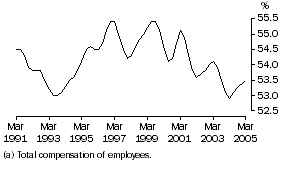
Gross operating surplus (GOS)
- The trend GOS of financial and non-financial corporations increased by 1.3% in the March quarter. Seasonally adjusted, GOS of financial and non-financial corporations increased by 2.2%, following an increase of 1.9% in the December quarter.
Profit(a) share of total factor income: Trend
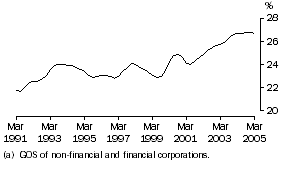
MAIN FEATURES STATE FINAL DEMAND CHAIN VOLUME MEASURES
 | Trend
| Seasonally adjusted
|  |
 | Quarterly % change Dec 04 to Mar 05 | Annual % change Mar 04 to Mar 05 | % points contribution to growth in DFD Dec 04 to Mar 05 | Quarterly % change Dec 04 to Mar 05 | Annual % change Mar 04 to Mar 05 | % points contribution to growth in DFD Dec 04 to Mar 05 |  |
|  |
| New South Wales | 0.6 | 3.2 | 0.2 | -0.1 | 2.5 | - |  |
| Victoria | 0.5 | 3.3 | 0.1 | -0.8 | 1.7 | -0.2 |  |
| Queensland | 0.6 | 5.4 | 0.1 | 0.4 | 6.1 | 0.1 |  |
| South Australia | 0.2 | 2.8 | - | - | 2.5 | - |  |
| Western Australia | 0.5 | 4.7 | 0.1 | 1.0 | 6.0 | 0.1 |  |
| Tasmania | 1.0 | 5.3 | - | -0.3 | 4.5 | - |  |
| Northern Territory | 2.2 | 3.4 | - | 5.9 | 7.4 | 0.1 |  |
| Australian Capital Territory | - | 2.4 | - | -0.8 | 2.5 | - |  |
| Australia (DFD)(a) | 0.6 | 3.8 | 0.6 | -0.1 | 3.4 | -0.1 |  |
|  |
| - nil or rounded to zero (including null cells) |
| (a) Domestic final demand. |
MARCH QUARTER
Summary Comments
State Final Demand
- In trend terms growth in the March quarter was strongest in the Northern Territory (up 2.2%) and Tasmania (up 1.0%) and weakest in the Australian Capital Territory (no change). In seasonally adjusted terms, the Northern Territory (up 5.9%) showed the strongest growth with the major contributor being private gross fixed capital formation. Seasonally adjusted growth was weakest in Victoria and the Australian Capital Territory (both down 0.8%).
Household final consumption expenditure
- In trend terms, all states experienced growth, ranging from 0.4% in New South Wales to 1.0% in Western Australia. Growth in seasonally adjusted terms was recorded in all states, with strongest growth in Queensland (up 1.6%).
Government final consumption expenditure
- Trend growth in the March quarter was strongest in Tasmania (up 1.6%) and weakest in Western Australia (down 0.5%). In seasonally adjusted terms the only state recording growth was Tasmania (up 4.0%). Seasonally adjusted growth was weakest in Queensland and the Northern Territory (both down 2.2%).
Private gross fixed capital formation
- The pattern of growth in trend terms varied across the states, with the Northern Territory showing the strongest growth at 7.7%. Seasonally adjusted growth was also strongest in the Northern Territory (up 33.3%), while Tasmania was down 7.5%.
- Investment in machinery and equipment fell across most of the states in seasonally adjusted terms with the largest decline in the Australian Capital Territory (down 22.8%). Small growth was recorded in Victoria and Western Australia. Non-dwelling construction investment (seasonally adjusted) rose strongly in the Northern Territory (up 55.2%) and the Australian Capital Territory (up 36.0%) with a large fall in South Australia (down 12.6%). Dwelling investment (seasonally adjusted) was strong in the Northern Territory (up 25.5%) and South Australia (up 7.3%) but fell 11.0% in Victoria, 4.9% in Tasmania and 2.6% in New South Wales.
Public gross fixed capital formation
- The pattern of growth in trend terms varied across the states. In seasonally adjusted terms, the strongest growth occurred in New South Wales (up 8.9%), while the Northern Territory had the largest fall (down 19.8%).
ANALYSIS AND COMMENTS
GROWTH RATES IN GDP
The graph below provides a comparison of the quarterly growth rates for volume measures of GDP in both seasonally adjusted and trend terms over the last fourteen years. Following the fall in GDP (in seasonally adjusted volume terms) in December quarter 2000 there have been 17 consecutive quarters of growth.
Percentage changes, Chain volume measures
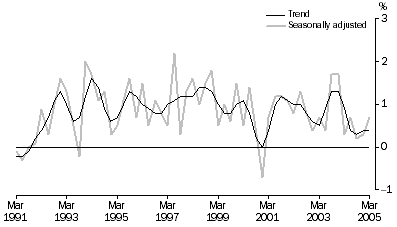
Growth (in trend volume terms) over the past four quarters has been driven by private investment in new machinery and equipment (up 18.0%), new engineering construction (up 6.4%) and household final consumption expenditure (up 3.6%). Offsetting these strong contributions was the strong rise in imports of goods and services (up 11.2%) and a fall in dwelling investment (down 4.6%).
On the industry side, the strongest contributors over the past four quarters have been cultural and recreational services (up 6.1%), transport and storage (up 5.7%) and health and community services (up 5.5%). Detracting from growth was a strong fall in agriculture, forestry and fishing (down 12.0%), and falls in accommodation, cafes and restaurants (down 2.7%) and manufacturing (down 1.7%).
REAL GROSS DOMESTIC INCOME
A measure of the real purchasing power of income generated by domestic production is the volume measure of GDP adjusted for the terms of trade effect, which is referred to as real gross domestic income (see Glossary for definition). The graph below provides a comparison of quarterly movements in trend GDP (volume measure) and real gross domestic income. During the March quarter, trend real gross domestic income increased by 0.7%, compared to the increase in the trend volume measure of GDP of 0.4%, reflecting an improvement in the terms of trade. Trend and seasonally adjusted estimates of real gross domestic income are shown in tables 1 and 2.
Percentage changes, Trend
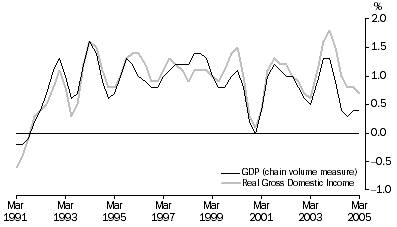
The graph below shows the trend terms of trade over the past fourteen years. The strong rise in the terms of trade since 1999 reflects strong growth in export prices relative to import prices and implies an increase in purchasing power for Australia relative to its trading partners.
Trend, (2002-03 = 100)
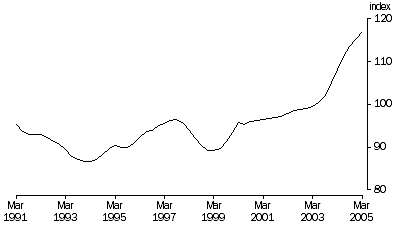
REAL NET NATIONAL DISPOSABLE INCOME
A broader measure of change in national economic wellbeing is real net national disposable income. This measure adjusts the volume measure of GDP for the terms of trade effect, real net incomes from overseas and consumption of fixed capital (see Glossary for definition). The graph below provides a comparison of quarterly movements in trend GDP (volume measure) and real net national disposable income. During the March quarter, trend real net national disposable income increased by 0.5%, while the increase in the trend volume measure of GDP was 0.4%.
Percentage changes, Trend
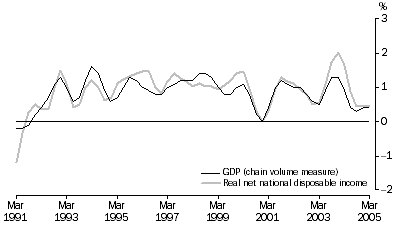
HOUSEHOLD SAVING RATIO
In both trend and seasonally adjusted terms the household saving ratio (see Glossary for definition) was negative in the March quarter 2005, implying that household consumption was greater than household disposable income. In both trend and seasonally adjusted terms the ratio was -3.3% in the March quarter 2005. The following graph presents the household saving ratio derived from trend and seasonally adjusted data.
Household saving ratio, Current prices
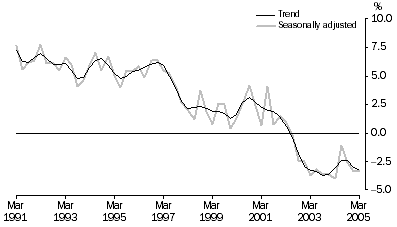
Although seasonally adjusted household saving has been negative over the past two years, net national saving has been positive over the same period. The net national saving ratio in the March quarter 2005 was 4.1% in seasonally adjusted terms.
Caution should be exercised in interpreting the household saving ratio in recent years, because major components of household income and expenditure may still be subject to significant revisions. The impact of these revisions on the saving ratio can cause changes in the apparent direction of the trend.
COMPENSATION OF EMPLOYEES
In March quarter 2005, seasonally adjusted compensation of employees grew by 1.9%, while the seasonally adjusted number of employees recorded in the Labour Force survey grew by 0.6%. Thus, average compensation per employee increased by 1.3%. This follows growth of 0.7% and 1.0% in the previous two quarters. The growth rate over the twelve months to March quarter 2005 was 3.5% in seasonally adjusted terms compared to 3.9% growth over the same period in the total hourly rates of pay, excluding bonuses as published in Labour Price Index, Australia (cat. no. 6345.0). (It should be noted that the conceptual bases for the two wage measures are different.)
PRIVATE NON-FARM INVENTORIES TO TOTAL SALES RATIO
In trend current price terms, the book value of private non-farm inventories increased by $1,421 million (1.4%) in March quarter 2005, while total sales rose by $975 million (0.8%). Consequently, the trend inventories to total sales ratio (see Glossary for definition) increased from 0.793 in the December quarter 2004 to 0.798 in March quarter 2005. The following graph presents the ratio of private non-farm inventories to total sales over the last fourteen years.
Trend, Current prices
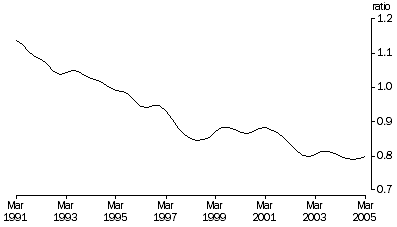
IMPORTS TO DOMESTIC SALES
The imports to domestic sales ratio (see Glossary for definition), trended and at current prices, remained unchanged in March quarter 2005 at 0.362. This reflects a rise of 1.1% in imports of goods accompanied by a 1.2% rise in domestic sales. The following graph presents the ratio of imports to domestic sales over the last fourteen years.
Trend, Current prices
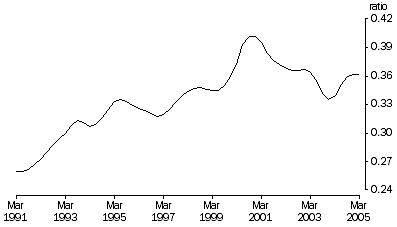
RELIABILITY OF CONTEMPORARY TREND ESTIMATES
Trend estimates are used throughout this publication as an alternative approach to the analysis of movements in time series data. Further details regarding the procedures used to estimate the trend series are described in the Explanatory Notes (paragraphs 13 - 17) and in Information Paper: A Guide to Interpreting Time Series - Monitoring Trends, 2003 (cat. no. 1349.0) released in August 2003.
Potential revisions to trend estimates can be indicated by showing the effects of particular changes in seasonally adjusted estimates that might occur in the next quarter. The table below shows the trend estimates for the last ten quarters and the values to which they would be revised if the given movements in seasonally adjusted GDP actually occurred in June quarter 2005. Seasonally adjusted growth of 0.2% is required in June quarter 2005 to maintain, in June quarter 2005, the trend growth of 0.4% currently estimated for the March quarter 2005.
Percentage change in GDP Chain volume measure |
|  |
 |  |  |  | Trend estimate if seasonally adjusted GDP changes by the following amounts in June qtr 2005
|  |
 |  | Seasonally adjusted GDP as published in table 2 | Trend GDP as published in table 1 | Grows by 1.0% | No change | Falls by 1.0% |  |
|  |
| 2002 |  |  |  |  |  |  |
 | December | 0.4 | 0.6 | 0.6 | 0.6 | 0.6 |  |
| 2003 |  |  |  |  |  |  |
 | March | 0.7 | 0.5 | 0.5 | 0.5 | 0.5 |  |
 | June | 0.4 | 0.9 | 0.9 | 0.9 | 0.9 |  |
 | September | 1.7 | 1.3 | 1.3 | 1.3 | 1.3 |  |
 | December | 1.7 | 1.3 | 1.3 | 1.3 | 1.3 |  |
| 2004 |  |  |  |  |  |  |
 | March | 0.3 | 0.9 | 0.9 | 0.9 | 0.9 |  |
 | June | 0.7 | 0.4 | 0.4 | 0.4 | 0.4 |  |
 | September | 0.2 | 0.3 | 0.3 | 0.3 | 0.4 |  |
 | December | 0.3 | 0.4 | 0.5 | 0.4 | 0.3 |  |
| 2005 |  |  |  |  |  |  |
 | March | 0.7 | 0.4 | 0.6 | 0.4 | 0.1 |  |
|  |
 Print Page
Print Page
 Print All
Print All